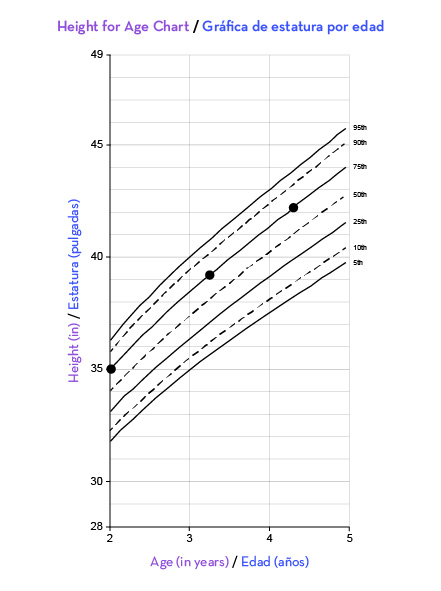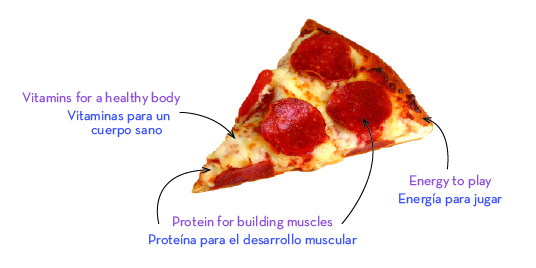Growing Every Day
Have you ever wondered if your child is growing the way they should? You are not alone. Many parents have questions about their child’s weight, size and development. Whether you want to better understand your child’s growth charts or support their body image, WIC can help!
Childhood Growth and Growth Charts
Your child’s growing body is something to celebrate! The early years come with many changes in height and weight. Growth spurts are common, and your child may go through periods of growing quickly and then slowly. This is normal.
Well-Child Visits and Measurements
Pediatricians recommend routine visits for your child beginning at birth. These visits are known as “well-child visits” and they are the best way to track your child’s growth.
As a part of the well-child visit, a health care provider will measure your child’s weight and length if your child is under 2 years old, or weight and height if your child is 2 years or older. Your WIC office will also take these measurements at scheduled WIC appointments. You can see your child’s WIC measurements and growth charts in the myWIC app.

What Are Growth Charts and Percentiles?
Growth charts are useful tools for tracking your child’s physical development over time. A growth chart will show your child’s weight, height, length or body mass index (BMI) compared to average values for children of the same age and sex.
Growth percentiles are found by marking your child’s measurements on a growth chart. Percentiles range from 0 to 100. They describe your child’s growth compared to other children their age.
For example, if your child’s height is at the 75th percentile, it means that in a group of 100 children of the same age and sex, your child would be taller than 74 children and shorter than 25 children.

How to View Your Child’s Growth Charts in myWIC
You can ask to view your child’s growth charts at the health care provider’s office or at your WIC office. You can also find growth charts for your child in the myWIC app.
To view your child’s growth charts in myWIC:
- Select your child’s name from the list of Members in the navigation menu.
- Select your child’s record under Measurements to view records from recent WIC visits. A list of your child’s measurements and percentiles will appear.
- Select Growth Charts at the top of the screen. Your child’s growth is measured on two sets of growth charts depending on age: Infant 0-24 months and Child 2-5 years. Choose which set of growth charts you would like to view.
- Your child’s growth chart is now visible. Use the drop-down menu to choose between growth charts for weight, length, height or BMI.
- For more details, click on each measurement point to view your child’s specific growth percentiles.
Following a Pattern
The way your child grows over time is called a growth curve. The growth curve is made by taking measurements at each well-child visit. Over time, these measurements form a curve on your child’s growth chart.
- An important sign that your child is growing well is that she is following her growth curve. This holds true whether your child is small or large for her age.
- Children can be healthy and show normal growth at many different percentiles. What truly matters is the pattern of your child’s growth over time. Steady growth follows a predictable pattern.
- In a typical pattern, growth increases quickly during infancy and then slows as a child gets older. Children often go through growth spurts and then periods without much change.
Whether children are large or small, their growth pattern is individual to them. Genetics, activity level, diet, medical conditions and life experiences influence growth. Even siblings may have different growth rates. For this reason, do your best to avoid comparing your child’s body or growth to other children. Growth curves provide a clearer picture of your child’s health.

Common Questions and Concerns
Supporting Your Child’s Body Image
Bodies Can Do Amazing Things
Raising children in a culture focused on dieting and body image can be difficult. Remember that a number on the scale or how a person looks does not define her worth or health. Bodies come in all shapes and sizes, and that is something to celebrate!
You can help your child learn to love her body and all the amazing things it can do.
- Avoid making comments based on body size or eating habits.
- Try focusing on what makes your child unique like their kindness, humor or creativity.
- Provide praise when your child is brave or works through something hard.

Be a Positive Role Model
Research shows that when parents talk about weight, it can impact their child’s eating habits and self-esteem.
- Be mindful about how much you talk about food or dieting. Try not to talk about weight or bodies, including your own.
- Children pay attention to those around them and are more likely to eat a variety of foods when they see others eating and enjoying them. You can set a good example by enjoying a variety of foods in a nonjudgmental way.
- Well-meaning family members, friends, teachers or other caregivers may not know the most helpful ways to support your child’s growing body. Take time to discuss any concerns you have with them in private. Let them know how you prefer to discuss sensitive topics like weight and food with your child.

Be Neutral About Food and Find Balance
All foods can help support your child’s growing body. Take the focus away from labeling foods as “good” or “bad.” Avoid restricting or making certain foods off limits – this can make children want them more.
Instead, be neutral and find balance. This lowers pressure around eating and helps your child learn to follow his hunger and fullness cues. Creating a positive relationship with food from an early age can help create a lifetime of healthy eating habits.
- Being neutral means talking about food differently rather than focusing on whether it is “good” or “bad.” Discuss the texture and colors of food, or how it helps our body instead.
- Finding balance means setting up structure to help all foods fit. Rather than making certain foods off limits (or having no limits), include them with meals in a mindful way. For example, try offering a single serving of a typical treat food as part of a meal. Children might eat more at first, but they will become naturally less interested over time.

Have Fun Moving Your Bodies Together
Encourage your child to move in ways that he enjoys and join in the fun! Being active together is a great way to bond and helps your child develop skills and learn to enjoy movement.
Find an activity you like and can do together without much planning or cost. You do not need to visit a special play space for children or enroll your child in group sports. Try simple activities like a dance party, stretching or fun games. The more enjoyable being active is, the more likely they will want to keep moving their bodies.

Healthy Habits for Your Child’s Growing Body
You can further support your child’s growth by helping him develop healthy habits that last a lifetime. Check out these resources for more:
- Learn about mealtime practices that create a positive relationship with food.
- Build balanced snacks to fuel play and growth.
- Find ways to mindfully celebrate special occasions.
- Explore ideas for getting active as a family.






 Have any questions?
Have any questions?
